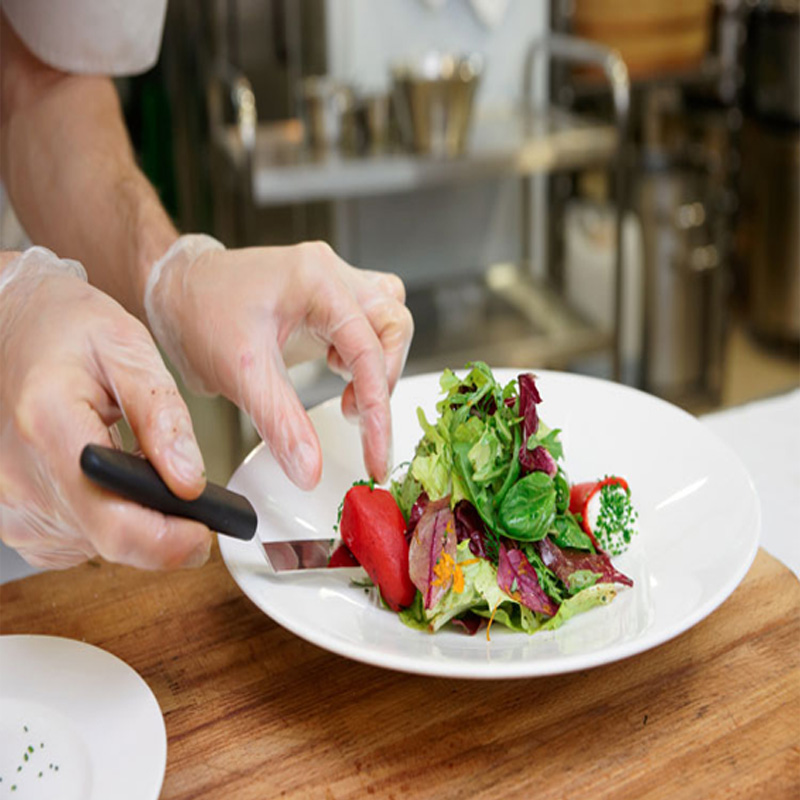Call Us: +8618816800624 / +8618816802426/ +8618816802430 Email Us: sales@pidegreegroup.com
Views: 20 Author: Pidegree group Publish Time: 05-28-2018 Origin: Site

Have you ever walked into the restaurant and only saw people behind the counter making your food without food handling gloves? It usually makes you doubt about the quality and safety of food, right?
This is a reasonable suspicion. The US Centers for Disease Control and Prevention estimates that approximately 48 million people in the United States receive food poisoning every year. A large part of these diseases are the lack of care for food handlers. When the numbers are high, you should take all precautions.
If you own a restaurant and you see that your employees do not wear gloves to handle the food, it is particularly frustrating. This is not only unhygienic but it also produces negative advertisements. If a customer sees an employee cutting chicken or mixing salad vegetables, they will immediately walk outside the door.
This is why it is very important to use food processing gloves. Below, we will explain how to use food handing gloves correctly to maximize food safety.
You would think that slapping on some latex gloves would be simple, but each state's health department has a variety of best practice guidelines for using food handling gloves. Each state has its own traits, but we will provide some general tips below.
If you have just fished through cow dung, gloves are useless. The focus of food handling gloves is to form a barrier between your hands and food. If the gloved hands are dirty, the gloves become less effective. This can cause bacteria on your hands to climb out of your gloves and food.
Wash your hands first and remember your nails!
This problem may lead to indirect food safety problems. Wearing gloves too big or too small may make your job harder. For example, gloves may slip from food and cause contamination. Or you may use too much gloves to cut the meat and let the knife slip from your hands and cut your fingers. Then, you are bleeding all over your body, wasting money and making customers feel sick. This is not good.
In addition to keeping food away from bacteria, food-handling gloves also prevent bacteria on other foods from moving away from the rest of the kitchen. So when you move from one workstation to another, be sure to change your gloves.
For example, if you are working in front of a range and you are rubbing raw meat with spices, you need to change gloves before starting salad polishing. Otherwise, you will get all the bacteria, such as e. E. coli and other bacteria on lettuce. Who wants e. Large intestines in their lettuce!
If you take off your gloves and go to the bathroom or lunch break, if you use them repeatedly, there is a high chance of contamination. This is because there are few places where they can be placed and they are not exposed to unwanted bacteria.
Even if you come back to the same station, you should change them. Just put a new pair and they will feel better.
Latex was once the first choice for food processing gloves. But recently, many people are allergic to latex. The best option is to buy gloves made of synthetic material or vinyl.
Another benefit of this is that the latex melts and contracts around the heat source. If you work under open fire all day, if you are not careful, latex may cause you a bad burn. The last thing you want is to put a layer of hot melt on your hands.
Spend a day sweating to a pair of rubber gloves and you have some very wet conditions on your hands. This moisture creates an environment where bacteria can multiply and multiply. This is the last thing we want.
So when you finish your shift, block your day by giving your hands another wash.
If you are working with rough paper cuts, or if your axe loses an axe, you must take extra precautions.
In such cases, make sure that you have cleaned the wound, put it on, and wrap it with a bandage before you put on your gloves. Blood-borne diseases can be cruel, so we must redouble our security here.
Gloves are not the end of food safety. They are not magical protection against bacteria. They are just a tool in your food safety library.
You must also make sure that the food you supply is being stored and cooked. In many countries, a general rule of the Ministry of Health stipulates that when food is refrigerated, it must be kept below 41 degrees. When it is cooked, it must be cooked to temperatures above 140 degrees. The temperature between these two extremes promotes the growth of bacteria.
Of course, some foods such as steaks will be cooked below this temperature, or in the case of sushi. This is why many restaurants have to leave a warning on the menu if they serve raw meat or fish.
With this information dragging, you are reading this kitchen and keeping the food in its original state. If you are an employer and need to store high quality gloves, please check out the food handling gloves we provide.
We can take care of all your glove based needs at affordable prices!
Email Us: sales@pidegreegroup.com
Add: Room 418, Building A5, NO.8 2nd Hezhan Street,
Baiyun, Guangzhou, Guangdong, China
Tel: 020-29836025
Mob: +8618816800624 / +8618816802426 / +8618816802430